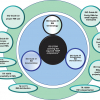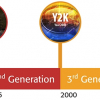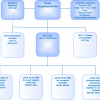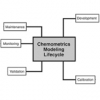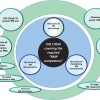Peter J. Jenks
the Jenks Partnership, Newhaven House, Junction Road, Alderbury, Salisbury, Wiltshire SP5 3AZ, UK
National laws, implementing the REACH Directive, came into force across the EU on 1 June 2007. The Directive aims to ensure that all chemicals used commercially in Europe shall be registered and the toxicity, bio-toxicity and persistence properly documented. In some cases, based on this registration process, the use of certain chemicals may be either severely restricted or completely prohibited. A new EU Chemicals Agency (ECHA, www.echa.europa.eu) has been established in Helsinki, Finland, to be responsible for this work.
Commercial use is, in simple terms, defined as a substance used by an organisation in an amount exceeding one tonne per year, known as product and process oriented research and development (PPORD). Even so, in this case suppliers need to submit a PPORD notification to ECHA.
So why should this Directive be of any real interest or concern to scientists working in a laboratory? Simply because the real impact is on suppliers and most lab reagents and solvents are sold by the main lab suppliers in quantities of much more than one tonne per year. So the suppliers have no choice but to be concerned and the consequences WILL cascade down to all lab scientists, in two main ways, as will be made clear.
The regulations include a specific exemption for research and technological uses where the chemical is produced and used in quantities of less than one tonne: this was done in the expectation that innovation and research would be largely unaffected. So it might be logical to think that other than for the main reagents, solvents and so on the readers of Spectroscopy Europe can ignore the impact of REACH, or at least take the view that REACH is another piece of well-meaning legislation that won’t have any real impact on day-to-day work. Sadly, this is not the case: REACH will impact on almost every analytical laboratory, especially those concerned with the environment and public health. How can this be?
The sting in the REACH Regulations is Substances of Very High Concern. These are substances that have hazards that have serious consequences, e.g. they cause cancer (carcinogenic) or they have other harmful properties and remain in the environment for a long time (persistent) and gradually build up in animals (bioaccumulative). This category also includes substances demonstrated to be of equivalent concern, such as “endocrine disruptors”. One of the aims of REACH is to control the use of such substances via authorisation and encourage industry to substitute these substances for safer ones.
The immediate consequence is that chemicals that are considered to be persistent, bio-accumulative and toxic (PBT-substances), or very persistent and very bio-accumulative (vPvB-substances) are not subject to the one tonne per year threshold. For these substances the ECHA reserves the right to require full registration prior to authorisation, restriction or prohibition.
The vast number of known chemical substances means that the full REACH process is sure to take much time. So that suppliers don’t prevaricate, ECHA has established a pre-registration status that will allow existing commercial and scientific use to continue until registration is completed. Amazingly, pre-registration is open ONLY from 1 June 2008 until 30 November 2008. Any chemical pre-registered by a producer or supplier company can continue to be sold and used until registration is called in by the ECHA, which may be any time from 2011 to 2026, but could be sooner, or later. So the first consequence of REACH is that any chemical meeting the criteria for registration, but not pre-registered by a company, cannot be sold in the EU after 1 January 2009 in quantities of more than 1 tonne per year... and for PBT and vPvB Substances may not be sold at all.......
It is important to realise that pre- and final registration links the chemical substance to both a selling company and a producer. Pre-registration can only be done on-line using the ECHA website. In theory all the supplier needs to do is prepare an Excel spreadsheet, using a template from the ECHA “REACH IT” portal, but even before the launch ECHA announced that the online registration software would not be fully functional on 1 June and as late as 21 July 2008 the REACH IT portal, was down for three days for critical technical revisions, including one to solve an incompatibility with certain functions essential to accessing the site using MS Explorer!
The REACH Regulation has reserved Annex 13 and 14 for substances that will be subject to authorisation: Annex 13 is specifically reserved for PBT-substances and vPvB-substances.
At the time of writing both are empty. This is because REACH has moved the onus to industry to pay all the costs (and more) and take all the risk as far as chemical registration is concerned. So the ECHA officers will wait for industry to tell them what it thinks should go into Annex 13 and 14. But if industry gets it wrong then ECHA will take action. To make the process even more challenging it is intended that Annex 13 and 14 will not be populated until pre-registration has closed, so companies can’t use other company’s registrations to get ideas on what should be registered. So most suppliers are taking a very cautious approach and are pre-registering everything!
For suppliers of specialist laboratory reagents, in particular environmental reference materials, the sting is that many of the key environmental pollutants and possibly some pharmaceuticals used as reference standards may be considered as PBT or vPvB and so need to be pre-registered under Article 13. At some point, once pre-registration has been completed then the ECHA will decide if a chemical substance should be called in for the full registration procedure. There is concern that for substances of very high concern, ECHA will call them in for full registration very early in the proceedings, possibly as early as late 2009.
Once registration is called in by ECHA then the real trouble starts. Full registration will require a mass of data, most of which is easily obtained for chemicals used in industrial quantities but for many of the materials used by an analytical laboratory as standards or reference materials the information is probably non-existent.
The theory is that to avoid duplication of effort and to share costs all the companies that have pre-registered a particular chemical substance will be invited to form a “Substance Information Exchange Forum” (SIEF). In theory these forums will remain functional until 2018 and once an organisation has joined a forum participation is mandatory and a participant cannot leave! Feedback from a contact I have that works with the heavy chemical and pharmaceutical industries suggests that these consortia will be lawyer led, because of anti-trust considerations, and that certain big manufacturers see this as a “legal” way to cut out small traders and importers from the European market as the small players will not be able to afford to take part. Why? It is believed that once a registration dossier is available the consortia will be able to decide the commercial basis for making this data available. This may be challenged in the European courts, but for now it seems non-consortia members will have to pay for access to the data.
What will all this cost? No one knows the real costs of developing data needed for registration, but published estimates from the industrial chemistry sector have varied from £50,000 to £5m per chemical substance. Clearly for most chemicals used by companies producing standards and reference materials to be used in the environmental and associated sectors the cost of registration, even as part of a consortia, would be commercially indefensible and in many cases it would be impossible to produce sufficient material to undertake any required testing. A further complication is that the source of most such materials is within the USA and the position of the US chemical industry towards REACH ranges from indifference to anger. Certainly most will not be prepared to get involved, on any terms.
So, from January 2009 it is very possible that REACH will have unintended consequences on the analytical laboratory world. The supply of key reagents and standards may begin to become difficult from 2009 as products that should have been registered are not found in Annex 14 and so their use is prohibited. Then later in 2009 or early 2010 if the Substances of Very High Concern are called in for full registration and full registration of these substances is not possible, due to either lack of information or the unwillingness of suppliers to cooperate, then ECHA may totally prohibit the use of the chemical within the EU. Certain optimists believe that the ECHA will see sense and establish a new small limit for chemicals that are PBT or vPvB but have an essential use as calibration standards or reference materials in testing required under EU Directives—but I’m not one of them.
So the result of REACH could be that key testing of food and water for persistent environmental toxins, required by one EU Directive, might become impossible because the very standards and reference materials essential to support and ISO 17025 Accreditation of testing laboratories will become unavailable because of a different EU Directive.....
More information
ECHA FAQ Book: www.echa.europa.eu/doc/reach/080611_REACH_ECHA_FAQ_2%202_Release_2.pdf
UK HSE REACH website: www.hse.gov.uk/reach/index.htm


